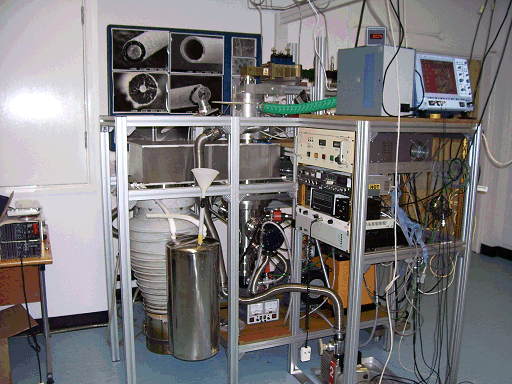 In Situ Molecular Beam Mass Spectrometry
In Situ Molecular Beam Mass Spectrometry
The main aim of this project is to study the gas phase chemistry occuring during microwave plasma diamond CVD using a Quadrupole Mass Spectrometer (QMS). The mass spectrometer samples from a continuous molecular beam extracted from the microwave plasma CVD chamber. This work follows on naturally from that of Roland Tsang who used MBMS to study the gas phase environment during hot filament assisted CVD, and then Stuart Leeds who modified the sampling cone assembly to enable us to apply the same techniques to MW plasmas. Later, James Petherbridge used the system to study low temperature growth using CO2/CH4 gas mixtures, as well as H2S additions for sulfur doping experiments. It was recently modified by Ed Crichton to allow investigation of the high pressure Ar/CH4/H2 gas mixtures that are used to deposit UNCD films. This involved a complete rebuild of the reactor, with the MS now sampling from below through a small orifice in the substrate holder. It is currently being used by Oliver Fox who has linked up all the control systems using Labview.
System description
 The system consists of a Microwave Plasma Reactor (right) to which the molecular beam sampling apparatus is attached. A 100 μm-diameter orifice in the substrate holder is used to extract a sample of the plasma gas as a supersonic gas expansion. The region immediately the orifice is pumped to ~1 mTorr by a large diffusion pump. The large pressure ratio between the reaction chamber (at maybe 150 Torr) and the region behind the orifice (1 mTorr) means the gas forms a supersonic expansion. The rapid expansion 'freezes out' any chemical reactions occuring, preserving the identity of highly reactive species such as radicals and ions, expected to be present in small amounts in the bulk plasma. This molecular beam is chopped by a mechanical chopper, to allow phase sensitive detection and background subtraction.
The system consists of a Microwave Plasma Reactor (right) to which the molecular beam sampling apparatus is attached. A 100 μm-diameter orifice in the substrate holder is used to extract a sample of the plasma gas as a supersonic gas expansion. The region immediately the orifice is pumped to ~1 mTorr by a large diffusion pump. The large pressure ratio between the reaction chamber (at maybe 150 Torr) and the region behind the orifice (1 mTorr) means the gas forms a supersonic expansion. The rapid expansion 'freezes out' any chemical reactions occuring, preserving the identity of highly reactive species such as radicals and ions, expected to be present in small amounts in the bulk plasma. This molecular beam is chopped by a mechanical chopper, to allow phase sensitive detection and background subtraction.
The central portion of the expanded gas then passes through a 1 mm-diameter skimmer forming a tight molecular beam. This beam now travels through the second stage of differential pumping which houses the QMS, supplied by Hiden Analytical. This stage is pumped to ~10-7 Torr by two 70 l/s turbomolecular pumps. The beam then enters the QMS where it is detected.
In theory, the beam detected by the QMS should have the same chemical composition as the bulk plasma. In reality, gas dynamic effects inherent in the supersonic expansion occur (such as mass discrimination and background gas scattering of beam molecules) and must be corrected for in order to give a correct picture of the CVD process chemistry. The MBMS system is versatile as it can monitor a wide range of species present in the sampling environment, simultaneously, unlike some of the other plasma-chemical diagnostics employed thus far where only certain species can be detected (e.g. Laser Induced Fluorescence, and Optical Emission Spectrometry). Absolute species mole fractions can be determined when the species of interest is available as a gas and used in the system at a known supplied concentration as a calibrant. The main drawbacks of the molecular beam system are the expense and complexity of building the system.
Recently we have done work studying standard CH4/H2 gas mixtures, as well as looking at the effect upon the chemistry, and the diamond film, of additions of chlorine-, nitrogen and phosphorus-containing gases. We recently used this system to examine novel gas chemistries, e.g. CO2/CH4 mixtures, and mixtures containing CO/CH4/H2. These are especially important gas mixtures since they allow diamond growth at much lower temperatures than the conventional CH4/H2 mixtures - maybe even as low as 400°C. We are currently using the system to study Ar/CH4/H2 gas mixtures that are used to deposit so-called 'ultra-nanocrystalline' diamond films.
To date, we have published about 20 papers on MBMS sampling from diamond plasmas, and these can all be seen on the publications page.
